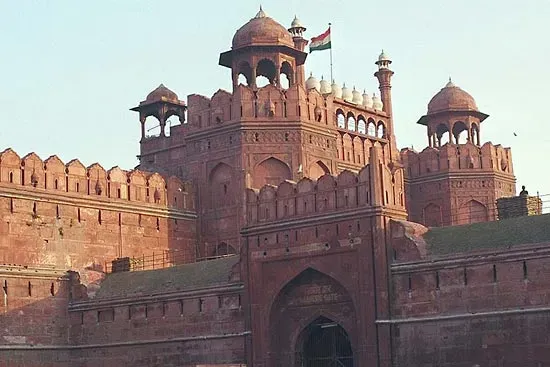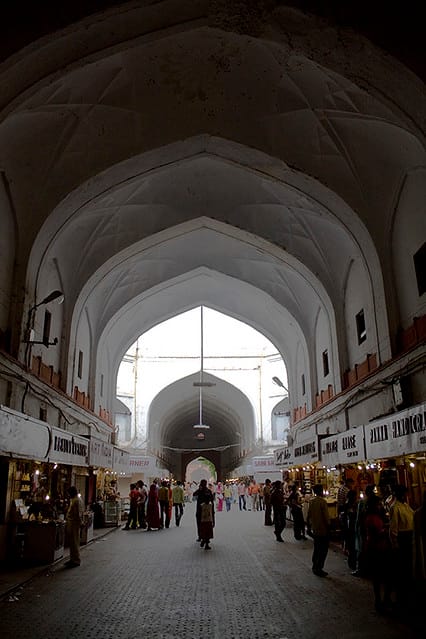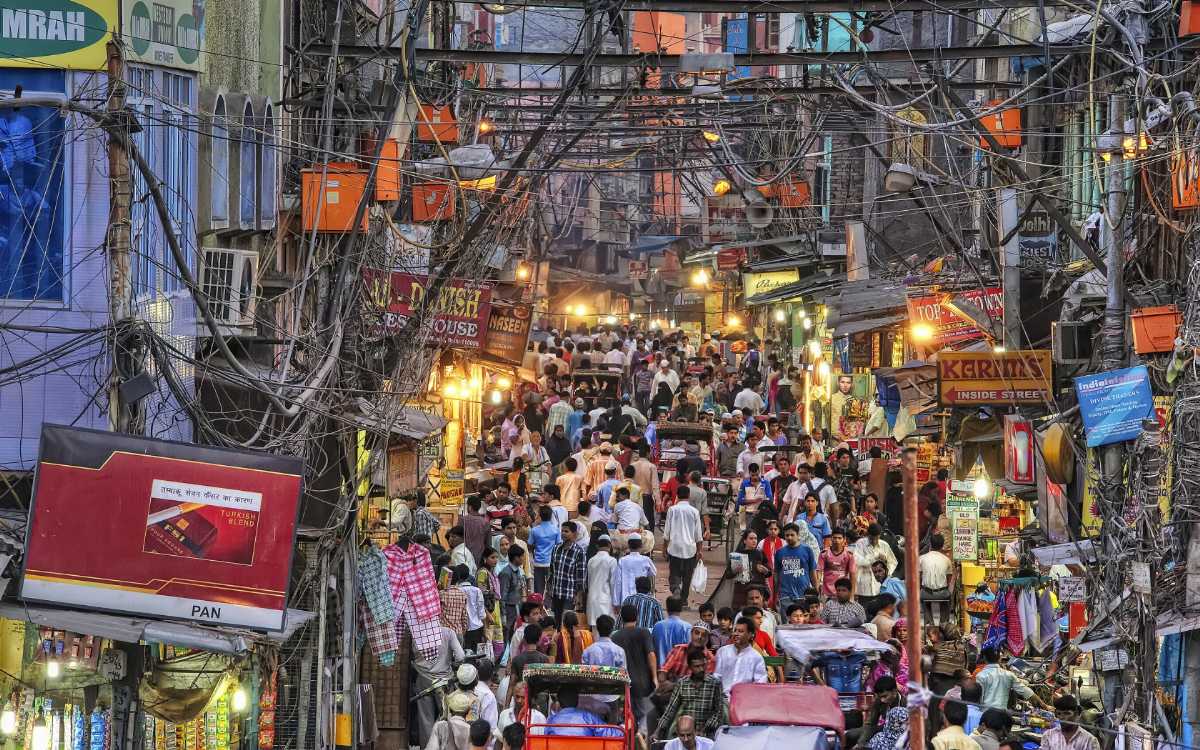Lal Qila
The Red Fort is one of the UNESCO World Heritage sites in Delhi and sees millions of visitors from all over the world every year

Take out a 500 rupee note from your pocket. Now, have a good look at it.
The impressive structure running across the length of India’s currency is the Red Fort—the diadem of Old Delhi, the true war theatre of 1857, and the pulpit from which the country’s Prime Minister unfurls the tricolour on Independence Day. The Lal Quila, which served as the seat of various empires, stands tall in the bustling streets of Chandni Chowk.
The Mughal Seat of Power

Mughal Emperor Shah Jahan ascended the throne after a bitter war of succession and left no stone unturned in marking the legacy of his rule through buildings that would marvel the generations to come. He shifted the empire’s capital to Delhi and built his new seat of power, Shahjanadabad, at the banks of the river Yamuna. The axis mundi of his kingdom came to be the Red Fort.
Built by the accomplished architect Ustad Ahmad Lahori, the brain behind the Taj Maha, this fort was built from red sandstone and white marble, giving it the name Lal Quila. Surrounded by majestic yet cascading walls and dotted with imposing bastions, the fort is nothing less than an architectural marvel. Its beauty lies in the effortless way it brings to life the harmonious union of Timurid, Persian, Islamic and Hindu architectural elements.
Originally, the Red Fort was known as the Qila-i-Mubarak or the Blessed Fort, and true to its name, the structure saw prosperity embracing the Mughals. It was the home of the bejewelled throne Peacock Throne which was believed to cost double the amount of the Taj Mahal. This beauty that could be rivalled only by the legendary Throne of Solomon, was also embellished by the Koh-i-Noor. It took almost a decade to finish the construction of the Red Fort and anyone who sees it would immediately understand why. Its magnificent palaces, mosques, gardens and pavilions are truly a sight to behold. Back in the day, the Lal Quila overlooked the River Yamuna which was far wider than now. Many historians have also suggested that a canal lined with trees, the Nehr-e-Bihisht or the River of Paradise was also a part of the palace compound. The Shahi Burj, which is believed to be Shah Jahan’s most cherished workplace, is a three-storey tower that helped lift water from Yamnu for this canal.
After the revolt was crushed, Bahadur Shah was sent to Yangon and his sons were killed. The mighty Mughal dynasty came to a tragic end and barracks to station the British Army were erected in the Red Fort. Today they serve as museums that contain exhibits on various themes like the 1857 Revolt, Jallianwala Bagh Massacre and the life of Subhash Chandra Bose.
Red Fort Through Ages
The Mughal dynasty saw its artistic heyday under Shah Jahan since Emperor Aurangzeb was wedded to austerity due to his religious inclinations and the needs of his ever-expanding empire. As the succeeding emperors failed to manage the kingdom, the Red Fort also suffered, witnessing a looting spree from Nadir Shah. Shah looted the fort, taking away the Peacock Throne and along with it, the Koh-i-Noor. When the Marathas got hold of Delhi after 1752, they melted the silver ceiling of Diwan-i-Khas in order to raise an army to fight Ahmed Shah Durrani. With their defeat, Durrani looted the Red Fort again, stripping away its former glory. In the constant power struggle against the Mughal, the seat of the empire moved into the hands of Jats, Sikhs and Marathas, who all wanted a share of their gains.
The final sunset for the Lal Quila came with the end of the Mughal Dynasty following the Revolt of 1857. An old Bahadur Shah Zafar II begrudgingly accepted the role of the leader of the uprising. Once it was brutally quelled and the Mughal dynasty put to an end, the Red Fort was systematically torn down. The physical manifestation of Mughal might was ripped apart bit by bit. The structure of the Lal Quila suffered great damage and could never be restored to its former glory. Although the fort was not the site of any military showdown, it symbolised the collective will of the Indian people that the British were fighting against. Many of its riches still adorn British museums and private collections, far from where they belong. Yet, despite such blows, the Red Fort still stands strong and proud as an essential part of history.
Major Attractions
Diwan-i-Aam

Comprising a large, open, front hall supported by huge sandstone columns, the Hall of Audience celebrated the true spirit of good governance. It was here that the emperor listened to the grievances of his subjects and received petitions. The hall is divided into 27 equal parts, contains a wall decorated in the pietra dura style and is inlaid with gold in the white shell lime chunam work. It was from a marble canopy here that the jharokha darshan ceremony took place.
Diwan-i-Khas
Also known as the Shah Mahal, the Hall of Private Audiences was meant for the interaction between the emperor and dignitaries. The ceiling of the hall was inlaid with precious metals and stones, a fitting canopy to the Peacock Throne. The Nahar-i-Bihisht flowed through the centre of the hall.

Lahori Gate
The Lahori Gate is the main entrance gate of the Fort and gets its name from the direction it faces. During his reign, Aurangzeb added a fortified outpost to the gate, a move which received great disdain from Shah Jahan. Today, the Prime Minister of India addresses the nation from this gate on Independence Day.
Delhi Gate
Just like the Lahori Gate derives its name from the fact that it faces the city of Lahore, the Delhi Gate is named because of its orientation towards the city of Delhi. Similar in appearance to the Lahori Gate, this gate opens towards Daryaganj. Lord Curzon placed two large stone elephants on this gate which can be seen even today.
Meena Bazaar
Also known as the Chatta Chowk, the Meena Bazaar can be easily accessed through the Lahori Gate. This was the marketplace from where the imperial women bought their jewels and silks. It was known as the Chatta Chowk or the Chatta Bazaar given the roof sheltering it.

Zenana
The Zenana, or the Women’s Quarters consisted of the Mumtaz Mahal and the Rang Mahal. It served as the residence for royal women and stood at the southernmost tip of the fort.
Mumtaz Mahal
The Mumtaz Mahal serves as the private apartment of Arjumand Banu Begum, popularly known as Mumtaz Mahal. Today, the Red Fort Archaeological Museum is run in this building.
Rang Mahal
The Rang Mahal or the Imtiyaz Mahal served as a resort for royal women. Built in a splendid fashion, five grand archways open towards the Mahal. A lotus-shaped fountain stands in the hall, whose waters gush through marble channels. Its walls are adorned with colourful mirror mosaic words, giving it the name Rang Mahal or Palace of Colors.
Khas Mahal
The Khas Mahal was the royal residence. Since it contained the imperial apartments, the Mahal had a sitting room or the baithak and a bedroom called the khwabgah. Divided into four parts, the Khas Mahal has a serene white verandah etched with intricate gold floral patterns.
Moti Masjid
Added to the Red Fort in 1659 by Emperor Aurangzeb, the Moti Masjid is a beautiful structure made of white marble. The mosque has three domes and is covered with exquisite carvings. The gates of the Moti Masjid are plated with burnished copper and are adorned with ornate motifs.
Lal Quila Timings and Ticket Prices
The Lal Quila is open to visitors from Tuesday to Sunday, with Mondays closed for maintenance. The visiting hours are typically from 9:30 AM to 4:30 PM. Ticket prices vary for Indian and foreign tourists, with Indian nationals charged a nominal fee of around INR 35-50 per person, while foreign tourists pay approximately INR 550-600 per person. Children below 15 years of age enjoy free admission.
Transport
To reach Lal Quila (Red Fort) in Delhi, India, travelers can utilize the city's extensive metro and bus networks. The nearest metro station to Lal Quila are Chandni Chowk, which is serviced by the Delhi Metro's Yellow Line and Lal Qila which falls on the Violet Line. From there, visitors can either take a short walk or catch a cycle rickshaw to reach the fort. Alternatively, several bus routes connect various parts of Delhi to Lal Quila, with bus stops located nearby for convenient access. Both the metro and bus routes offer affordable and efficient transportation options for tourists and locals alike to explore this iconic historical site.
Food Near Lal Qila
Paranthe Wali Gali
Paranthe Wali Gali, nestled in the heart of Old Delhi, is a narrow alleyway renowned for its delectable parathas, traditional Indian flatbreads. Lined with small eateries, this culinary haven offers a diverse array of paratha fillings, ranging from classic potato and paneer to unconventional options like rabri and banana. Among its famous restaurants, Pandit Gaya Prasad Shiv Charan stands out for its century-old legacy and authentic recipes. Another gem is Pt. Kanhaiyalal Durga Prasad Paranthe Wale, known for its mouthwatering varieties and vibrant atmosphere.
Chandni Chowk
Chandni Chowk is a bustling market in Old Delhi. Amidst its labyrinthine lanes, numerous iconic restaurants offer a culinary journey through Indian flavors. Karim's, a legendary eatery established in 1913, tantalizes taste buds with its Mughlai delicacies like kebabs and biryanis. The Mohabbat ka Sharbat is a must-have during summers, while the Shahi Tukda found here is hard to beat. Ghantewala, dating back to 1790, tempts with its mouthwatering sweets, especially the iconic Sohan Halwa. Al-Jawahar is famous for its meat-based curries, whereas Qureshi Kebab Corner serves some of the most delicious and rich seekh kebabs you’ll ever have. Natraj Dahi Bhalla Corner delights with its savory lentil fritters soaked in yogurt. Chandni Chowk's gastronomic heritage beckons food enthusiasts from far and wide.

Other attractions near Lal Quila
Jama Masjid

Jama Masjid, is one of the largest and most iconic mosques in the country. Commissioned by the Mughal Emperor Shah Jahan in the 17th century, it represents the zenith of Mughal architecture. The mosque's grandeur is evident in its colossal size, with a spacious courtyard capable of accommodating thousands of worshippers. Its striking red sandstone and marble domes, minarets, and intricate carvings exemplify Mughal craftsmanship. Inside, the prayer hall is adorned with Persian calligraphy and elegant arches. As a symbol of religious and cultural heritage.Just 1.5 kilometres away, one can easily hitch a rickshaw to Jama Masjid and enjoy the food nearby.
Vijay Ghat
Vijay Ghat is a memorial dedicated to the memory of India's second Prime Minister, Lal Bahadur Shastri, located in Delhi, India. Constructed near the banks of the Yamuna River, it serves as a place of homage and reflection for visitors paying tribute to Shastri's contributions to the nation. The simple yet elegant design of the memorial features a black marble platform with an eternal flame symbolizing Shastri's enduring legacy. Surrounding greenery and tranquil surroundings offer a serene atmosphere for contemplation. Vijay Ghat stands as a reminder of Shastri's principles of simplicity, integrity, and commitment to the welfare of the people.
Raj Ghat
Raj Ghat, located on the banks of the Yamuna River in Delhi, India, is a serene memorial dedicated to Mahatma Gandhi, the father of the Indian nation. Surrounded by lush greenery, the simple black marble platform marks the spot where Gandhi was cremated after his assassination in 1948. Inscribed with the words "Hey Ram" (Oh God), Gandhi's last words, the memorial attracts visitors from around the world who come to pay their respects and reflect on his teachings of non-violence and civil disobedience. Raj Ghat stands as a poignant reminder of Gandhi's enduring legacy and his contribution to India's freedom struggle.
Feroz Shah Kotla Fort
Feroz Shah Kotla Fort, located in Delhi, India, is a historical fortress built by Sultan Feroz Shah Tughlaq in the 14th century. This imposing structure symbolised Tughlaq power and boasts remarkable architectural features, including massive walls, bastions, and grand gateways. The fort also houses several prominent structures such as a mosque, a palace, and a baoli (stepwell). Notably, it is believed to have been constructed on the site of the ancient city of Ferozabad.



Comments ()